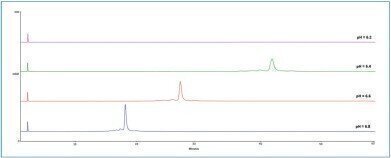Bioanalytical
How to develop a method for commercial MAbs using a Dial-a-mix method and YMC’s BioPro IEX SF column
Dec 08 2020
Monoclonal antibodies (MAbs) are immunologically active proteins, which bind specifically to certain cells or proteins. The impact of MAbs is becoming increasingly important for the treatment of different types of cancer and autoimmune diseases. Nowadays, a wide variety of therapeutic antibodies are available on the market and several more are in research and development.
How to find the optimum pH and salt gradient
Cation exchange chromatography (CEX) is perceived to be the gold standard for the charge sensitive characterisation of monoclonal antibodies. For charge variant analysis of MAbs the IEX method development requires finding the optimum pH value and salt gradient. A relatively easy way to approach this is to use a quaternary pump HPLC and the dial-a-mix method. This enables the lab scientist to utilise all four mobile phase bottles/lines to very easily (and quickly) screen various pH conditions and salt gradients.
Once the most appropriate conditions are determined, the method can be fine-tuned for optimal performance. The method can then be transferred to a binary HPLC system if desired, for simplicity and improved reliability. Using a buffer with lower pH than the isoelectric point (pI) of the targets will retain the analytes carrying a net positive charge, allowing for proper binding/interaction with the CEX stationary phase.
Identifying optimum conditions for three commercial MAbs
This technical note shows how to run a fast pH screening with YMC’s BioPro IEX SF using a dial-a-mix method with a quaternary HPLC pump and a salt gradient. For this application three different commercially available MAbs: Cetuximab (Erbitux®), Bevacizumab (Avastin®) and Rituximab (MabThera®) with isoelectric points (pI) varying from 8.3 to 8.7 were screened with four different potassium phosphate buffers.
Conclusion
The data shows that YMC’s BioPro IEX SF performs well when using the dial-a-mix method for early screening of pH and salt gradient parameters. This method of screening allows for faster method development, with sample analysis being completed overnight in some cases. Once the data is analysed and approximate method parameters are obtained from dial-a-mix screenings, the method can then be converted to a two-mobile phase system using a binary pump HPLC. This helps minimise any variability from using a quaternary pump for mobile phase mixing, and allows for optimisation of final method parameters.
Events
Apr 22 2025 Kintex, South Korea
Analytica Anacon India & IndiaLabExpo
Apr 23 2025 Mumbai, India
Apr 27 2025 Portland, OR, USA
May 11 2025 Vienna, Austria
May 18 2025 Tempe. AZ, USA












